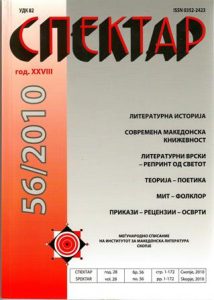ЕСТЕТИКАТА НА ГРДОТО / ДЕКОНСТРУКЦИЈАТА НА ВКУСОТ (врз примери на современиот роман)
THE AESTHETICS OF THE UGLY
Author(s): Afrim RedžepiSubject(s): Novel, Psychoanalysis, Theory of Literature
Published by: Институт за македонска литература
Keywords: aesthetics; deconstruction; psychoanalisys; ugliness; taste; novel
Summary/Abstract: The ugliness is determined through rejection, terrible, disgusting, unpleasant, revulsion, shameful, rude, horryfing, monstruous, smelly, pathetic, unattractive, deformed, uncomfortable etc. The ugliness itself destroys the identity, system, order, does not respect frontiers, positions and rules. The aesthetics of ugliness, artistic retelling of ugliness demonstrates the ordination, that beauty is inugliness. In that way we determined three different phenomena: the ugliness in itself, formal ugliness and the artistic representation of both phenomena. Contemporary artists use the ugliness, not as avangarde settings, but to point out of the world’s circulation through aesthetic effects of ugliness / aesthetic excitement for today’s recipient, who again percepts the divine proportion. Typical example is the director George Romero in the film The night of living dead. For Derida the relation towards being is not a spectacular relationship, but being has the other one in itself. Life is inside in differance / difference which links. The implication of the theory of Derida Me is heterogeneous /the other stays in me as an alter ego (for example Necropolis, The Great Pashaluks and The Peeper are autobiographical /auto –fictional novels with the other me of the author are texts with two texts inside, with two hands, with two peeps, judgments and feelings. According to Christeva, The Other becoming alter ego, saves “ Me”, through disgusting, terror, ugliness, not to disappear. Art becomes locus of an eminent critics of aesthetic education, an aesthetic education against aesthetic education. The confrontation of the aesthetic apologetic education and critics in the concrete artistic pragmas, are essential references for creating the role of the artist in the era of globalization and its instrumental pragmatism.
Journal: Спектар
- Issue Year: 2010
- Issue No: 56
- Page Range: 113-118
- Page Count: 6
- Language: Macedonian

